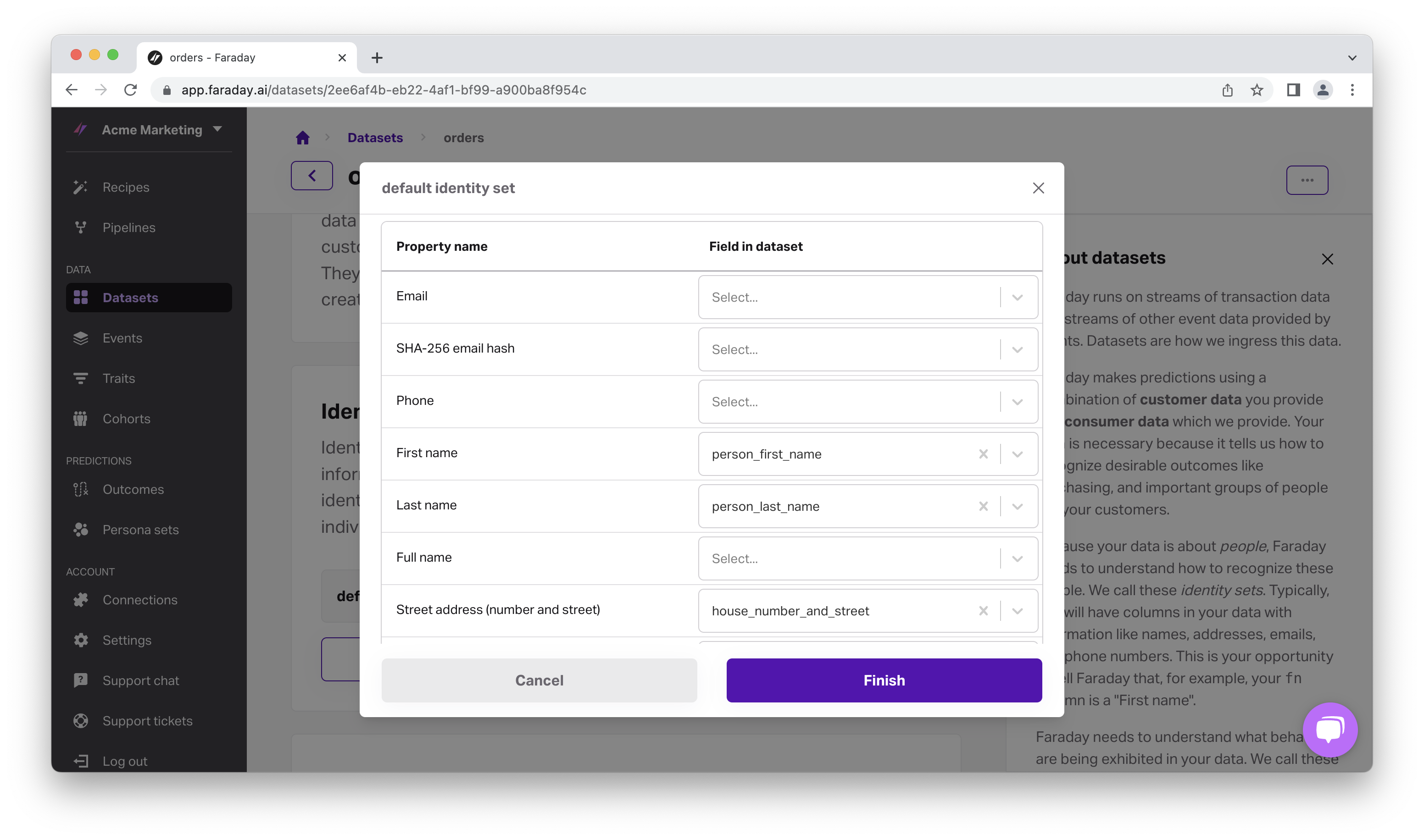Personalized direct mail: How can direct mail be personalized at scale?
Learn the benefits of personalized direct mail marketing, how to personalize your direct mail campaigns, and how to use predictive analytics to maximize impact.


What is direct mail marketing?
Direct mail marketing is the act of a brand engaging with its customers and prospects through physical mail. It can come in various forms, from postcards, to letters, to branded water bottles, and everything in between. The most effective direct mail campaigns are highly personalized to resonate with a brand’s customers. Before email and digital engagement became the norm, direct mail was one of the best ways to reach your customers. While digital has since pushed direct mail marketing to the side, it’s had a resurgence in recent years because, in the age of digital media, personalized direct mail stands out–assuming you’ve done your due diligence and personalized it appropriately to match your customers’ wants and needs. Take PostcardMania for example, who has seen their revenue grow 17.56% each year post-pandemic in comparison to 4.67% pre-pandemic.
Benefits of personalized direct mail
Personalized direct mail has a variety of benefits over digital to prove that it’s a great supplement to your engagement strategy. To start, the response rate of direct mail marketing is 9%, in comparison to the 1% of email, paid search, and social media. Additionally, it has a 29% ROI compared to 23% for paid search and 16% for online display. The benefits of personalized direct mail stem from two key features:
The first is that personalized direct mail can be tailored to a greater extent than its alternatives. Say that you know a group of your customers are avid runners that regularly buy running gear from your store. A digitally-focused brand might launch a campaign between major purchases for that group of people, where they want to offer them a free water bottle for being a loyal customer. An email offering the freebie will look a lot like other emails they receive, so it’ll likely be discarded, even if it’s genuine. With a brand savvy in personalized direct mail, the water bottle could be at their doorstep–delivered in a box personalized with running-focused creative–then in their hands as it becomes their daily drinker that they freely advertise for you.
The second is that, in the digital age, people are used to receiving all manner of marketing emails, to the point that it’s almost second nature to mark something as spam, or delete it. Personalized direct mail is more distinctive, and is much more likely to be seen by your customers. After all, 77% of people sort their physical mail immediately according to the USPS. With a chance that high for your mail to be seen, making use of personalized direct mail that resonates with your customers is the key to standing out.
How can direct mail be personalized?
Personalized direct mail can be accomplished through several different means that utilize your first-party data, such as merge tags and creative variations. With machine learning and third-party consumer data on top of your first-party data, you can accomplish it more effectively, and at scale.
Leverage data and machine learning for insights to guide personalization
To start, your customer data needs basic identifiers, like name and address, so that you know where to send your personalized direct mail. On top of that, you need to leverage all of your first-party engagement data, like products purchased, abandoned carts, subscriptions, and so on, to ensure any offers you make are relevant. You wouldn’t want to find a postcard with a discount in your mailbox for cat food when you don’t own a cat, would you?
Regardless of how strong your first-party data is, it provides limited insight into who your customers are beyond their interactions with your brand. With rich, third-party consumer data that includes demographics, psychographics, lifestyle, financials, and more, you can take your segmentation to the next level, enabling you to customize your copy & creative so that it resonates.
In addition to leveraging both first-and-third-party data, using machine learning to identify distinct groups–personas–allows you to create personalized direct mail at scale, with each group can be targeted with its own resonant, relevant engagement.
Use insights to inform your personalization
A uniquely powerful way to personalize direct mail is to make use of merge tags. With merge tags, you can personalize on an individualized basis so that any data you have that’s relevant to your customers can be utilized. This way, beneath the persona-level segmentation, your personalized direct mail is dynamic enough to include datapoints like, say, someone’s name, subscription level, or the city they live in. On top of that, if you have physical locations, merge tags can be used to point customers to your nearest storefront.
Personas also enable distinct creative variations that are relevant to each persona. For your Exercise Guru Elayne persona, you could include imagery of women running alongside a dog and while pushing a stroller, because the majority of the persona are dog owners and have children in the household.
Take your personalized direct mail even further by adding customized product offers and discount codes that are relevant to each persona. Maybe, utilizing your customer data, you know that a specific group of your customers have already purchased a pair of running shoes. You know they won’t need another pair for a while, so a promo for that will bounce off. An offer for a pair of running socks or shorts, on the other hand, is more likely to catch their attention.

Image via TheMailShark.
Pillars of a personalized direct mail strategy
There are three pillars to a successful personalized direct mail strategy.
- Insights: Identify distinct customer segments and their related insights by generating AI-powered personas. Through these insights, you have clear indicators for how to engage your customers and leads in ways that are highly resonant with their lifestyles.
- Customization: Determine how you’ll customize direct mailers based on your insights, data, and promotions. The most impactful personalized direct mail campaigns will include a mix of products, imagery, discounts, and merge tags, ensuring you’re including the right content. Brands that offer personalized direct mail services, provide a range of these types of services.
- Targeting: The cost of direct mail can add up–especially if you’re not targeting the best fits. Predict for likelihood to buy, convert, repeat purchase, churn, or any other relevant datapoint so that you’re spending your time and money where they matter most.
How to implement a personalized direct mail strategy with Faraday
With a customer prediction platform like Faraday, you can identify personas to gain rich insights and predict behaviors so that you can deliver resonant, personalized direct mail to likely-to-act audiences. All it takes is some historical data about your customers. Here’s how it works.
Connect data and define customers
To start, you plug in your data by mapping your data fields to Faraday properties.
Then, in cohorts, you’ll utilize both your customer data and Faraday’s rich, built-in consumer data to build the exact cohort–or interesting group of people–you want. In Faraday, you’ll create a cohort for your customers so that you can find more people like them, and you’ll also build a cohort of people with mailable addresses, so that you’re also targeting unknown audiences. You'll do this by choosing the following traits when building a cohort:
- Record quality code: one of: mailable
Predict personas to reveal rich insights
While you likely have customer data that indicates, in some ways, who your customers might be, predicting personas tells you who they really are, and what makes them tick. Dive into trait breakdowns like age, gender, household income, hobbies, and more–each one guiding you toward engaging with the right messaging.
Predict propensity to buy to target best fits
Next, you’ll build your predictive outcome by defining your attainment cohort as your customers, as that’s your prediction’s finish line–you want more people like your customers. In this example, we’re defining the propensity to buy, or the likelihood that anyone in the U.S. is going to become a customer by making a purchase, but you can predict for virtually any action that someone is likely to take, such as a conversion, repeat purchase, or churn.
With your prediction defined, create a pipeline to make them actionable by choosing your likely buyers outcome, your persona set, and your mailable cohort.
Faraday’s machine learning algorithms then predict how likely people are throughout the U.S. to buy your product, while also revealing which people belong to what persona on an individual basis.
Deploy personalized direct mail predictions to your stack
Likely buyer scores revealing your best fits across the country? Check. AI-generated personas providing clear guidance for personalization? Check. With these insights in-hand, deploy them anywhere in your stack you need them–for example, to a direct mail provider–then, design your copy & creative so that it caters to the personas you’re engaging with.
Ready to try it out? Create a free account.

Faraday
Faraday is a predictive data layer that helps brands and platforms understand who their customers are and what they’re likely to do next. We connect first-party data with privacy-safe U.S. consumer context from the Faraday Identity Graph and deliver production-ready predictions and datapoints you can activate across marketing, sales, and customer journeys.

Ready for easy AI?
Skip the ML struggle and focus on your downstream application. We have built-in demographic data so you can get started with just your PII.




